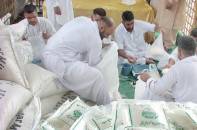The dollar problem
Emerging markets count the costs

Barely recovered from a two-year bout of Covid, emerging markets now face capital flight, inflation, and even debt defaults as the dollar’s run to two-decade highs tightens the screws.
Almost all past emerging market crises were linked to dollar strength. As the dollar rises, developing countries must tighten monetary policy to head off falls in their own currencies. Not doing so would exacerbate inflation and raise the cost of servicing dollar-denominated debt.
For all the improvements of recent decades, those equations still broadly hold and the recent dollar rally is leaving a trail of destruction in its wake.
Soaring commodity prices are another complication, alongside the tumble in China’s yuan – an anchor for Asian and commodity currencies. “The cracks are widening. When a strong dollar intersects with high commodity prices, it’s not strange that we get problems in emerging markets,” said Manik Narain, head of emerging markets strategy at UBS. “And when the yuan weakens there are no winners in EM.”
Currency conundrum
Dollar appreciation has pushed an emerging currency index down 3.5% this year to an 18-month trough, though that masks bigger 9%-15% losses on currencies such as Poland’s zloty and Turkey’s lira. Losses also picked up in April, coinciding with the yuan downturn.
Flexible exchange rates do shield developing economies against a repeat of crises of the 1990s.
Back then, a surge in the US currency and Treasury yields first sparked Mexico’s crisis in 1994, subsequently sending shockwaves across Asia, Russia and Brazil as dollar pegs collapsed one-by-one.
But a stronger dollar still means higher imported inflation, especially given 30%-40% increases in food and oil prices. Currency declines also probably helped precipitate the recent heavy investment outflows from emerging markets.
As recession worries spread around world markets, the shine is coming off this year’s bright spot – commodity-exporting Latin America. The copper-reliant Chile’s peso gained 8% in the first quarter, only to fall 10% since then.
Growing pains
Central banks across the developing world have jacked up interest rates by hundreds of basis points cumulatively to tame inflation and ensure a sufficient inflation-adjusted bond premium to rising US yields.
As a result, emerging economies may expand just 4.6% this year, the World Bank forecasts, compared with an earlier 6.3% prediction.
Dollar strength can also dampen growth as it tightens financial conditions – a gauge of how easy it is to obtain credit. An emerging markets financial conditions index from Goldman Sachs is near the tightest since 2008, up some 300 bps this year.
Published in The Express Tribune, May 12th, 2022.
Like Business on Facebook, follow @TribuneBiz on Twitter to stay informed and join in the conversation.



















COMMENTS
Comments are moderated and generally will be posted if they are on-topic and not abusive.
For more information, please see our Comments FAQ